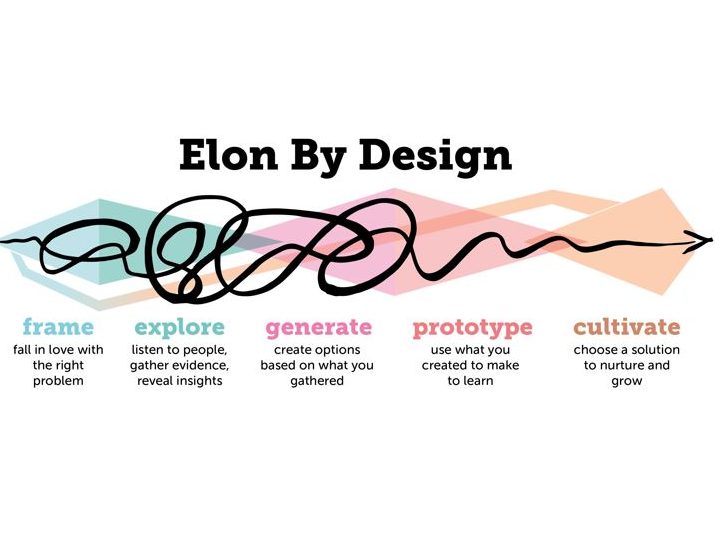Assistant Professor of Communications Michele Lashley explains how she is applying design thinking in her classes to prepare students for successful careers.
Since Elon By Design’s inception, supporting student learning at Elon by working with students, faculty, staff and others has been the chief goal. One way the Center for Design Thinking has pursued this goal is by working with faculty in their classrooms to link design thinking concepts to course content and learning outcomes.
Assistant Professor of Communications Michele Lashley has partnered with the Center for Design Thinking to co-create several class sessions at the center for her students. In this Q&A, she shares how she and her students are applying design thinking.

What were you hoping to learn or achieve in exploring design thinking?
I’ve been intrigued with design thinking for several years. And it’s ideal for what I teach in the School of Communications. So, I was thrilled when Dawan Stanford, consulting director of design thinking, and Danielle Lake, director of design thinking came on board at Elon. I’ve worked with both of them to implement the principles of design thinking in almost every class I teach because the approach dovetails so nicely with the work my students are doing.
I tell students that, once they learn how design thinking works, they can use it throughout their lives to solve a wide variety of problems. For example, for our strategic communications majors, the empathy phase puts them in the shoes of users. What are their challenges? What are their dreams? What keeps them up at night? It also teaches us not to make assumptions. Sometimes, the problem is different than you thought it was, and the empathy stage gives you the best possible understanding of the users, their needs and their “pain points.”
In the prototyping phase, you build concepts and models and take them back to those interested in your work to see if they resonate. It helps take the guesswork out of developing products and services. By the end of this stage, you should have a much clearer view of how those interested in your project might engage with it, think and feel when interacting with the finished product. You’ll know what they need and want, which means you are more likely to be able to provide them with what they’re looking for.

What are your biggest goals for your students?
What I really love about design thinking is how it helps hone students’ critical thinking skills. Often, the instinct is to jump right into tactics, but that’s a mistake. You have to ask questions and develop strategies before you can start thinking about creative solutions.
When my students join the global workforce, I want them to already be in the habit of thinking about problem-solving in an intentional, organized, yet creative way. You can apply design thinking in any industry. So whether they go into the nonprofit or for-profit sectors, they can become thought leaders if they can understand a process like design thinking and how to apply it to any circumstance.
How has design thinking influenced the way you approach your classes?
The Center for Design Thinking has been gracious in sharing resources with me and my students. Even though I was already familiar with the concepts of design thinking, I learn just as much from the workshops as my students do. The Center for Design Thinking is a genuine benefit to me and the students in my classes.
I recently brought two sections of my Corporate Publishing classes over to the Center for Design Thinking for a project kickoff. Danielle took them through a workshop focused on the customer journey, which was amazing. The feedback from the students was overwhelmingly positive. They found so much value in what they learned and are now implementing that knowledge as we move forward with the work we’re doing in the classroom.

What would you say is the most significant benefit of design thinking?
There are three answers to that question, depending on the audience:
The benefit to me is that it provides a proven problem-solving framework I can use when working with clients, making it easier to develop successful strategic and creative solutions.
The focus on developing creative, low-stakes prototypes saves resources for clients. This helps prevent them from wasting money on solutions that aren’t based on a true understanding of their audience.
And finally, the benefit to the user is that the information, product or service becomes much more valuable to them because their experience with that product or service is based on what they actually need or want.
If we can help our students learn more about design thinking principles in a way that allows them to clearly and quickly see the benefits, I think they’ll eagerly embrace it and apply it. This is a tool we can give them that they’ll be able to use both professionally and personally throughout their entire life.
Interested in working with the center? Contact the center at elonbydesign@elon.edu



